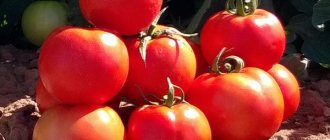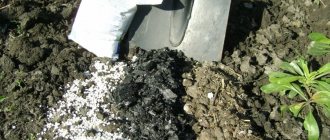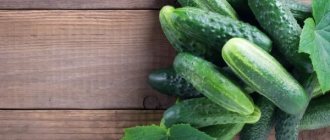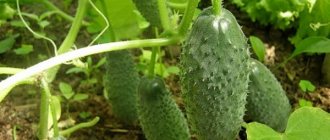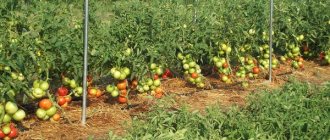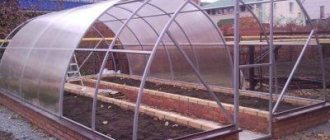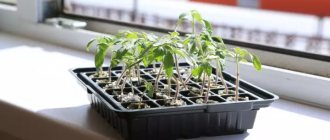Composition of ash and the role of each element in cultivation
When we talk about ash, we mean what is left after burning trees and plants, that is, organic materials. It contains a large number of elements that peppers and tomatoes need. Let's look at each element separately.
Calcium and the role of its salts
Most of the ash contains calcium and varieties of its salts. This element has a beneficial effect on the growth of plantings and is responsible for the balance of their nutrition.
No less useful are calcium salts, which in ash are represented by four main types:
- Calcium carbonate. Responsible for the balance of biochemical processes that occur in planting cells. Improves the passage of minerals into the plant. Accelerates the growth and ripening of fruits, increases productivity.
- Calcium silicate. It is able to combine with pectins, due to which the nutrient molecules stick tightly to each other and fully reach the roots and ovaries. Helps roots synthesize the maximum amount of nutrients from the soil. Improves the absorption of microelements. Improves the taste of harvested tomatoes.
- Calcium sulfate. The main element of industrial fertilizers, an invariable component of superphosphate. The concentration of this element in purchased formulations is certainly higher, and the effect is more active than that of ash. But when it gets into the soil with ash, its beneficial properties work not on the intensity, but on the duration of action. It accelerates plant growth and promotes the formation of healthy leaves and flowers.
- Calcium chloride. Tomatoes require small quantities. Plays an important role in the processes of photosynthesis and enzyme formation. Participates in the process of converting ammonium nitrate, which is found in all types of soil, into a salt of nitric acid. Provides prevention of putrefactive diseases, disinfects the soil. If there is an excess of calcium chloride, the plant may get sick or even die.
Potassium and phosphorus
Ash contains much less potassium and phosphorus than calcium. But even such a low concentration is enough to provide the plantings with the required amount of these microelements.
They take an active part in metabolic processes, ensuring the penetration and absorption of important microelements from the soil. Potassium stimulates flowering and fruiting, and phosphorus improves nutrition of plant roots. In ash, these elements are represented by two types of compounds:
- Potassium orthophosphate. Regulates water balance. Promotes the removal of ammonia from the roots and upper parts of plants, which reduces the growing season.
- Sodium orthophosphate. It is important for many capricious varieties of tomatoes as an integral element for their normal growth and development. It is the only available activator of a number of enzymes that cannot be affected by other substances.
Magnesium
The ash contains three magnesium compounds, which are very useful for normal plant growth. Magnesium is one of the main components of chlorophyll and also plays an important role in photosynthesis. With his direct participation, the required amount of energy is produced. Activates the formation of carbons, from which, in turn, starch and cellulose are formed.
With magnesium deficiency, crops wither, flowering begins very late, and fruits ripen poorly.
Composition and beneficial properties
It is difficult to name the exact chemical composition of the substance, since it depends on what plant residues were burned.
An approximate formula was derived back in the 19th century:
- Calcium carbonate – 17%.
- Calcium silicate – 16.5%.
- Sodium orthophosphate – 15%.
- Calcium sulfate – 14%.
- Potassium orthophosphate – 13%.
- Calcium chloride – 12%.
- Magnesium carbonate – 4%.
- Magnesium sulfate – 4%.
- Magnesium silicate – 4%.
- Sodium chloride (Rock salt) – 0.5%.
It is easy to calculate that the main element in the composition is calcium.
It is calcium that tomatoes need during the growing season:
- Calcium carbonate promotes the occurrence of biochemical processes in tomato cells, therefore stimulating active growth and accelerated ripening of fruits.
- Calcium silicate helps the plant absorb other nutrients from the soil, and also helps saturate the fruit with vitamins.
- Calcium chloride activates fermentation and stimulates photosynthesis processes.
Potassium, phosphorus and magnesium are contained in ash in smaller quantities, but despite this, it is sufficient to normalize metabolic processes in plant tissues. Potassium orthophosphate regulates water balance and prevents the accumulation of ammonia. Potassium ensures abundant flowering and proper formation of fruits. Phosphorus activates the activity of the root system. Magnesium compounds take part in the formation of carbohydrates. Their deficiency causes slower growth, flowering and fruit ripening.
Types of ash and the content of basic elements in it
Depending on what organic materials the ash is obtained from, its composition may vary. We have prepared a table from which you can clearly see which plants need to be burned in order to obtain ash with the desired biochemical characteristics. It presents approximate average concentrations of the three main elements.
| Percentage (%) | |||
| Organic | Calcium | Potassium | Phosphorus |
| Coniferous trees | 35 | 6 | 2 |
| Deciduous trees | 30 | 10 | 3 |
| Cereal straw | 4-8 | 15 | 6 |
| Peat | 20 | 1 | 1,5 |
| Buckwheat straw | 18 | 33 | 2 |
| Sunflower stems | 19 | 38 | 2 |
Under no circumstances should it contain any admixture of household waste, as this can lead to the death of the plantings.
Kinds
The ash of sunflower, pine needles, and deciduous trees is suitable for fertilizer. The remains of potatoes, wheat, rye, and grapes are rich in microelements. Many summer residents compare this fertilizer with superphosphate. The exact composition depends on what plants and trees it is made from:
- coniferous contains up to 35% calcium;
- wood – up to 17% calcium;
- cereal – about 8% calcium, 8% phosphorus;
- sunflower – up to 40% potassium;
- buckwheat – about 35% potassium;
- slate – up to 80% calcium.
Depending on what mineral the tomatoes lack, the type of fertilizing is chosen. Ash affects the properties of the soil, its composition and acid-base balance. It is used on neutral or alkaline soil. It contains carbon dioxide, which increases the pH of clay substrates.
In an acidic environment, it can further increase the acidity. Under such conditions, phosphorus and potassium undergo changes and are not absorbed by tomatoes. The standard dose is 200 g per 1 sq. m. Alkaline soils can be given up to 500 g per 1 sq. m. If gardeners do not know their soil type, use the product sparingly.
The remaining ash is left for next year. The main thing is to place it in a dry container and close it tightly. Then the useful components will remain in it for a long time. With regular use of ash, the growth of bushes improves, the ovary forms faster and the fruit ripens. It repels insects and prevents the formation of rot.
How to get ash for fertilizer
As mentioned above, to obtain good ash, it is necessary to burn material of exclusively plant origin. Straw and dry branches left over from gardening can be used. Larger logs will also work, but they will burn longer and, accordingly, it will take more time to prepare the ash. The best materials for producing nutritious ash are sunflower stems and fern plants, and less effective ash is obtained after burning peat.
Experienced gardeners give several tips for obtaining ash to fertilize seedlings:
- To start a fire, it is best to take a large enamel barrel. It will prevent the flame from spreading throughout the area and make it easier to collect the resulting fertilizer.
- It is better to prepare for burning vegetation in advance. To do this, dry fallen leaves and branches should be collected in bags throughout the year.
- The combustion container used must be protected from moisture. In addition to the fact that the material will take longer to burn, most of the nutrients will evaporate along with the liquid.
- The resulting ash should be sifted through a sieve so that only fine particles remain. They dissolve better in water and nourish the earth more intensively.
- The remaining ash can be packed in thick plastic bags or sealed containers and stored in a dry, dark place. Only in this way can it last up to 6 months without losing its beneficial properties.
Important! The resulting ash is not always acceptable for use. Sometimes it can have a pronounced reddish tint, which appears due to excess iron formation. It is strictly not recommended to use such a product as a fertilizer. It can cause irreparable harm to plants.
Feeding tomatoes with ash and methods of using it
Feeding tomatoes with ash has a long history, but today this type of fertilizer is still one of the most popular among gardeners. Back in the 19th century, the combustion products of organic matter were studied; scientists were able to obtain the approximate composition of those microelements that are found in wood ash. It contains calcium carbonate, calcium sulfate, calcium silicate, calcium chloride, potassium and sodium orthophosphate in almost equal proportions. It contains slightly smaller quantities of magnesium silicate, magnesium chloride and magnesium carbonate. Sodium chloride closes the list. Almost all of these substances can have a beneficial effect on the composition of the soil and improve the condition of plants. By the way, ash can also be used when growing tomatoes on the balcony.
Important! Only ash from plant residues is suitable for feeding tomatoes. Do not add paper or other household waste that may end up in the fire. Harmful combustion products will eventually end up in the fruits if they do not cause the death of the plantings first.
Ash for tomatoes is an excellent feeding option. It can be used either in dry form, digging into the soil, or making a solution for spraying and watering.
Dry ash
Tomatoes love loose soil, in which air circulates easily and where moisture easily gets in. If the soil is too heavy and aeration is impaired, then adding dry ash will be an excellent solution to this problem.
It is enough to carry out this procedure only once every 2 years. The table below shows approximate proportions for different types of soil.
| Soil type | Amount of ash, g | Coverage area, sq.m. |
| Loam | 800 | 1 |
| Light sandy | 200 | 1 |
| Peat | 500 | 1 |
Add 200 g of dry powder per 1 square meter.
The procedure is carried out once every 2 years, observing the following proportions:
- On heavy soils and loams – 800 g per 1 sq./m;
- On the lungs – 200 g per 1 sq./m or 2 tbsp. l. on the root in the hole;
- On peat 500 g per 1 sq./m.
- In sandy soil, you can also apply fertilizer to the hole immediately before planting in the amount of 2 tablespoons per plant.
Such fertilizer will be a good preventative against the appearance of pathogenic bacteria and pests, and will also saturate the garden bed with essential nutrients. So this is an important point in caring for tomatoes.
Solutions and infusions of ash
You can either water the soil with the ash solution or spray the plants themselves. As a rule, this processing method is used during the active growing season.
There are several recipes for preparing ash infusion. We will tell you about the most common of them; all options are easy to prepare at home.
- 150 g of ash are dissolved in 10 liters of warm water. The substrate is infused for about 4 hours. For better dissolution, it is recommended to stir it periodically. The resulting liquid is poured into the ground under the root at the rate of 0.5 liters for each planting.
- 50 g of ash are diluted in a five-liter flask with warm water. The solution is infused for about 6 hours, after which a little liquid soap is added. It will help the fertilizer stay on the leaves. The resulting mixture is sprayed on tomato plantings.
- To obtain a more concentrated substrate, 150 g of ash is poured with boiling water and left for at least three days in a warm place, stirring occasionally. Before processing tomatoes, the liquid must be strained.
Important! It is enough to feed tomatoes with ash only twice a season. In June, fertilizers are applied during the formation of buds, the second time feeding is carried out approximately in mid-July, when the first ovaries appear on the tomatoes.
Multicomponent fertilizers with ash
Ash is definitely an excellent all-purpose fertilizer. But in combination with some other elements, the ash solution becomes even more nutritious and beneficial.
In the table below we will present you the most popular folk recipes among gardeners and their preparation step by step.
| Combination | Quantity of ingredients | Cooking method | Application |
| Ash and salt Ash | 1 tbsp salt, 1 cup ash, 10 l water | All ingredients are mixed with each other. Leave for an hour. | Use for watering the soil, not suitable for spraying. |
| Ash, iodine, boric acid Ash Iodine Boric acid | 4 liter containers of ash, 10 liters of water, 1 tsp of boric acid, 25 drops of medical iodine. | The ash is dissolved in hot water, after cooling, the remaining ingredients are added to the solution. | Can be used for both root and foliar feeding. |
| Ash and yeast Yeast Ash | 10 g yeast, 2 tbsp granulated sugar, 10 l water, 1 tbsp ash. | Initially, yeast and sugar are diluted in a small amount of warm water and placed in a warm place for 5 days. Then ash and water are added to the resulting substrate, after which it is left to ferment for another 2 days. | This yeast fertilizer is suitable for root feeding in an amount of 0.5 liters per plant. |
| Ash and grass Ash herbal infusion | 10 liters of water, half a container of chopped herbs (nettle, plantain and burdock), 300 g of ash. | Add the herb to a container of water and leave it in a warm place for 7 days, stirring regularly. Then ash is added. | When root feeding, water the plant at the rate of 0.5 liters of the resulting substrate per bush. |
Application of ash solution
First you need to sift the ash. Then add 1 tbsp to 2 liters of boiling water. spoon of fertilizer, leave the solution in a warm place for a day so that it infuses. Next, strain the solution. You can water the seedlings with this solution when 2 true leaves grow.
Attention! You can also make a similar solution and place the seeds in it before sowing, this improves the germination of the seeds and they germinate faster. Leave the seeds in the solution for 2 hours.
It is quite easy to make an ash solution for feeding tomatoes; this solution is usually used to feed grown bushes. Pour 100 g into a ten-liter bucket of warm, clean water, leave for 3-4 hours, and then water the tomato bushes, pouring at the root. 500 g of solution is poured under 1 bush.
After pouring the solution under the bushes, within 7 days you will see the effectiveness of this feeding. The plants look healthy and have begun to grow vigorously.
How to prepare an ash solution for feeding tomatoes on leaves and stems?
Sift the ash and pour 300 g into 3 liters of water. Next, pour into a saucepan. Boil for half an hour. Then dilute with water until the solution has a volume of 10 liters. For better adhesion to the leaves, add another 50 g of grated laundry soap. Leave it for a day. Spray bushes with this solution if there is a lack of nutrients, and also to repel insects, for example, aphids.
To help more active fruit set and improve their taste, you can apply the following fertilizing. Pour 2 cups of wood ash into 2 liters of boiling water, leave for 2 days, then strain. Then add another 10 g of iodine, 10 g of boric acid. Pour in another 20 liters of clean water. Spray the bushes with the resulting solution when flowering.
Application of ash at different stages of tomato growth
When planning feeding tomatoes, it is necessary to take into account what stage of growth the plant is in. The frequency, type and concentration of treatment will depend on this.
Seeds
Already at the stage of soil and seed preparation, ash can be used. Before planting, it is added to the soil, and to increase the viability of the seeds, they should be soaked in an ash solution immediately before being placed in the soil. To prepare the solution, take 1 teaspoon of ash, add 1 liter of warm water and leave for about 6 hours.
Seedling
After preparing the holes for planting future tomatoes, they can be filled with a small amount of a mixture of sand and ash. The main thing is not to overdo it. The delicate roots of young plants can get chemical burns and die if there is a high concentration of ash. Low-acid soil needs such bait most of all. If the pH is above 7, then it is not recommended to further alkalize the soil. As a rule, amateur gardeners do not have a device to accurately measure the level of acidity, so it is better to start introducing ash into the ground with the smallest portions or simply sprinkle the planted seedlings with a weak infusion of ash.
Ash during picking
When picking seedlings into separate pots, ash is added dry to the bottom of the holes, 2 tablespoons each. Before transplanting the seedling, it is mixed with soil and a little water is poured into the hole.
Fertilizing the soil before planting seedlings
Heavy soil should begin to be prepared for planting tomatoes in the fall. The earth is combined with ash and carefully dug up. If the soil is sandy and light, then it is better to postpone the work of applying fertilizers until the beginning of the thaw, when at least two weeks remain before planting. Otherwise, all useful substances will simply be washed away along with the melting snow. For 1 sq.m, 150 - 200 g of dry ash will be enough.
After planting the seedlings
Gardeners recommend root and foliar feeding of already planted tomatoes no more than twice a season - in early June and mid-July. It is advisable to add 20-40 g of laundry soap to the ash solution. It will add disinfectant properties and ensure adhesion of the finished fertilizer to the leaves and stems of tomatoes. To make the soap dissolve better, rub it on a fine grater and pour in hot water, stirring. The resulting concentrate is poured into a solution with ash.
During flowering
For the flowering period, ash fertilizer is prepared in advance, since a full infusion requires at least a week. 2-3 cups of ash are dissolved in 10 liters of water and stirred periodically. At the moment the first inflorescences appear, 0.5 liters of solution is poured under each bush once every 1-2 weeks, depending on the condition of the soil and plantings.
During fruiting
During the period of fruit development, foliar feeding of tomatoes is carried out. The leaves are sprayed with a solution of sifted ash, which is boiled in the liquid for about 20 minutes, and then filtered and cooled to a temperature of at least 22 degrees.
Ash composition - macro and microelements
To know how to feed tomatoes with ash correctly, you need to know well what wood ash contains and in what quantities. This will determine when to apply ash fertilizers, in what quantities, and how many times a year.
After combustion, all substances turn into ash. The exception is nitrogen - it escapes into the atmosphere with smoke. This is probably the only drawback of this type of fertilizer - the lack of nitrogen. Ash for feeding tomatoes should be combined with nitrogen fertilizers.
Remain in ashes:
- potassium;
- phosphorus;
- calcium;
- magnesium;
- manganese;
- boron;
- iron;
- sulfur;
- silicon.
There are about 30 microelements in total. The composition differs when young branches and old ones are burned. Young people have more potassium, old people have more calcium. Trees whose wood is softwood have less potassium. These are linden, aspen, and conifers. Trees with hard wood have more potassium - oak, beech, poplar. You can get more potassium by burning weeds.
Straw from grain crops is a valuable raw material for the preparation of ash, especially buckwheat and rye.
Video: Effective feeding with ash
How to properly feed tomatoes with ash
There is no big difference in the frequency of fertilizing tomatoes planted in open ground and greenhouses. The main indicator of the need to apply fertilizer is the condition of the tomatoes themselves.
In the open ground
Gardeners do not recommend combining ash fertilizer with manure and droppings. The fact is that this type of organic matter releases nitrogen, which, in turn, absorbs the calcium present in the ash. Thus, these types of fertilizers neutralize the beneficial properties of each other. If you still plan to fertilize the soil with animal waste products, then it is better to do this in the fall, and leave the addition of plant ash in the spring.
In the greenhouse
In open ground, tomatoes are subject to additional moisture from precipitation, which improves the passage of micronutrients from the ash to the roots of the plantings. In the greenhouse, incl. made of polycarbonate, this process will have to be controlled independently. Therefore, after adding dry ash to the roots, it is necessary to further moisten the soil in order to dissolve the beneficial substances. To prevent diseases and improve soil quality, it is recommended to alternate ash with other universal fertilizers.
Contraindications for the use of ash
Despite all the positive qualities, ash has a number of contraindications:
- Red-colored ashes should not be used. This is an indicator of excess iron;
- Combustion products of film materials, paint, newspaper and glossy publications, plastic and food waste are not suitable;
- Trees grown along highways are not recommended for burning, as they, and subsequently the ashes, will be oversaturated with heavy metal compounds, including lead;
- If plants show signs of an excess of potassium and calcium: changes in the color of leaves and their premature falling, tomatoes acquire a brown tint, then the use of ash in any form is contraindicated for them;
- A balance must be maintained when combining ash with other industrial fertilizers.
- Incompatible with fresh manure. This reduces the percentage of nitrogen in organic matter and promotes the formation of mineral compositions that are not absorbed by plant roots;
Ash from tomato diseases
Ash solution helps gardeners get rid of numerous tomato diseases detected in the early stages. If the plantings begin to wither, it is necessary to examine them from all sides in order to understand the true reason for what is happening. There may be several of them.
- The appearance of blackleg can be caused by a lack of sunlight. Adding ash around the bush will help raise the soil temperature to speed up the evaporation of excess moisture from the soil.
- When affected by late blight, it is useful to apply root feeding. In early June, the ground near the bushes is lightly sprinkled with ash. The second such procedure is carried out during the formation of the ovaries of future tomatoes.
- Fungal diseases. They are treated based on where the tomatoes grow. If they are planted in a greenhouse, then you need to treat not only the bush itself, but also the inner surface of the walls. If we are talking about plants in open ground, then it is enough to carry out ash treatment of the visible parts of the tomatoes.
- Spraying vegetables with ash extract helps against blossom end rot of tomatoes: 2 tbsp. per liter of water (glass per bucket).
Experienced gardeners recommend using ash obtained by burning oak or maple branches to combat fungus. Other ash is generally not very effective.
For treatment, treatment should be carried out 2 times a week until the fruits are fully ripened.
Treatment of fungal diseases with ash
In addition to all of the above, soot is an excellent assistant in the fight against fungal diseases. The scourge of tomatoes, especially at the end of summer, is late blight, which can destroy the entire crop or most of it.
In the initial stages of the disease and until complete remission, it is necessary to dust with the combustion product once every two weeks as follows: throw small handfuls over the tomatoes - the ash settles and covers the fruits and greenery of the bush with a layer. This method is most effective in greenhouse conditions with closed windows and doors.
The effectiveness of the method can be increased if you mix the base with tobacco dust and treat the plants with this complex.
Tomatoes are not spared from powdery mildew, which extremely weakens the plant, drawing out all nutrients and blocking the processes of photosynthesis. The reason for its appearance may be excess nitrogen in the soil.
Therefore, ash, as a product that does not contain nitrogen and additionally enriches the soil with oxygen, is introduced in dry form or as an ash solution into the soil, which stimulates the healing process.
Protecting tomatoes from pests using ash
To prevent the appearance of pests on tomatoes, an ash solution is used. It is used once every 2 weeks, pouring the solution under the root of the plantings. This treatment will help improve the protective properties of plants.
To prepare the nutritional mixture you will need:
- 1 glass of ash;
- 10 liters of water.
The ash is poured with warm water and left to infuse in an enamel container for two days. The solution must be stirred at least 2-3 times a day. The resulting mixture is filtered and poured into the sprayer.
Some gardeners prefer a different method of preparation. For this you need to take:
- 300 g of ash,
- 10 liters of water,
- 50 g of laundry or green garden soap.
First, the ash is poured with two liters of water and boiled over low heat for about 30 minutes. After the substrate has cooled, it is filtered and the soap ingredient is added to it. If you use laundry soap, we first recommend grating it on a coarse grater for better dissolution. After this, the resulting concentrate is brought to a volume of 10 liters with water.
The substrate is sprayed onto the plants at the rate of 1.5-2 liters per bush.
These recipes will help against aphids on tomatoes.
To combat caterpillars and slugs, you can sprinkle 10 g of ash around each tomato.
When should ash not be used?
Ash is a completely organic and environmentally friendly fertilizer. But you also need to be able to use it correctly so as not to harm the plants. Many gardeners make common mistakes that have a detrimental effect on the growth of tomatoes. Below we will look at the basic rules for working with ash.
- Germinating seeds should not be sprinkled with ash. It is applied only when the plant rises above the soil level and there is access to the root system. Foliage is treated with an ash solution only for therapeutic purposes if a disease is suspected.
- You should not feed tomatoes until they have 2 true leaves. During this period, plants require nitrogen for normal growth and development, and potassium and calcium contained in the ash reduce its concentration in the soil.
- Pure ash cannot be mixed with the roots; it should be mixed with soil. Otherwise, your tomatoes run the risk of chemical root burn. After adding the ash-sand mixture, the hole must be filled with at least 1 liter of water and only after that the tomato should be planted in it.
- Ash does not combine well with other types of fertilizers. It should not be mixed with manure, compost or peat. The only elements in combination with which the effectiveness of ash increases are urea, saltpeter and potassium chloride. But you need to mix such a cocktail immediately before adding it to the soil.
- Ash and nitrogen should never be applied at the same time. They neutralize each other's beneficial actions. Gardeners recommend adding nitrogen in the fall and leaving the ash for the spring. By the way, ammonia (ammonia) is a source of nitrogen. So ash is not mixed with it.
- Ash should not be mixed with fertilizers containing phosphorus. The components it contains impede the passage of phosphorus to the roots and reduce its availability for planting.
- Ash fertilizers are not recommended for use on soil that has undergone liming. This can lead to an increase in calcium content in the soil, and its excess has a detrimental effect on tomatoes.
- Ash is not used to fertilize highly alkaline soils (pH 7 and above), this can lead to difficulty in the absorption of nutrients by the plant.
Advice! If your milk has gone sour, don't throw it away. Just pour it on the plant, it's an excellent fertilizer.
Errors and contraindications for use
How do you use ash?
DryLiquid
Improper use of ash can cause harm to plants instead of the expected benefit.
To prevent this from happening, follow the following recommendations from experienced gardeners:
- Do not add the substance to mullein solution or organic compost. This combination reduces the amount of nitrogen in the fertilizer and is not accepted by plant roots.
- Do not feed tomato seedlings with ash infusions until they form 2 true leaves. During this period, plants need nitrogen, and phosphorus and potassium will delay the development of seedlings.
- When adding ash to holes, mix it well with the soil to avoid burning the roots. Then pour in at least 1 liter of water. Only after this place the plant in the hole.
- Do not apply nitrogen fertilizers and ash to the soil at the same time. The procedures must be carried out at different periods: add ash in the fall, and compost and humus in the spring, or vice versa.
If the soil acidity in the area is less than 7 units, ash is not used. Its application will increase the alkali content and make it difficult for plant roots to absorb nutrients.
Tomatoes must be fed with ash in accordance with the rules and dosages. This fertilizer is natural and does not accumulate in the fruits. Don’t make mistakes in applying fertilizers, and your tomatoes will delight you with a bountiful harvest.
Feeding peppers with ash: pros and cons
The main advantage of feeding with ash is that it contains a huge amount of useful micro- and macroelements. They have a beneficial effect on the growth of peppers:
- Calcium, like all types of its compounds, normalizes metabolic processes at the cellular level and improves the absorption of nutrients. Helps perennials survive the winter by increasing their frost resistance. Thanks to calcium, annual plants better tolerate unexpected night frosts after planting.
- Orthophosphate plays a leading role in maintaining water balance in plant cells. If its concentration is too low, ammonia will begin to accumulate in the tissues, which disrupts the growth process and reduces the yield of peppers.
- Peppers need magnesium at the bud formation stage. It activates their development and helps in the flowering process.
- Sodium compounds are vital for the normal development of bell peppers. They stimulate the growth of plantings and activate the process of formation of ovaries and fruits.
- Phosphorus is important for the root system of peppers. Thanks to its presence in the soil, the passage of all useful microelements improves, making the roots nourished and strong.
Thus, we can say that ash is the best fertilizer option for peppers, since it contains all the elements loved by this crop.
But this does not mean that fertilizer should be applied uncontrollably, guided by the postulate “the more, the better.” An excessive concentration of ash in the soil can lead to alkalization of the soil, and this will have a detrimental effect on plantings, even though peppers love slightly acidic soil.
Fertilizers must be applied consistently; this is done only a few times throughout the entire season. You can only use ash left over from burning organic matter. There should not be any household waste in it, not even paper. And it’s still not worth combining ash with other fertilizers; it is already a self-sufficient fertilizer. Ash and nitrogen generally have zero compatibility; the interval between their application to the soil should be at least 1 month.
Rules for feeding tomatoes in a greenhouse
In a greenhouse, as well as in open ground, tomatoes need regular feeding. When applying fertilizers, it is necessary to maintain a balance between organic and mineral substances. If you overdo it with organic matter, the bushes will grow healthy and powerful, but problems will arise with the formation of ovaries.
If there is an excess of mineral fertilizers, the plants will not be able to absorb moisture normally and may die. Tomatoes need nutrients at every stage of growth. The bushes begin to be fed while the seedlings are growing. When transplanting plants into a greenhouse, the holes are filled with ash, humus and compost. This nutrient mixture is used for absolutely all varieties.
In the future, fertilizing should accompany each stage of tomato development, focusing on the appearance of the bushes. Greenhouse tomatoes become vulnerable to diseases precisely because of a lack of essential minerals. It is recommended to use both root and foliar fertilizers.
It is also necessary to take into account that tall, powerful varieties of tomatoes are usually grown in a greenhouse, which are in dire need of all macro- and microelements for normal growth and fruiting, so the soil is depleted very quickly.
Adequate nutrition will help plants resist fungal diseases and extend the fruiting period.
Adding ash at different stages of pepper development
Before planting peppers, you can mix ash with sand and add the mixture to the prepared holes. Young seedlings can be carefully watered with ash infusion. It is better not to pour out too much volume, but to divide it in half for double watering.
If you do not plan to add nitrogenous fertilizers to the soil, then in spring and autumn you can dig up the soil and add ash to it. If the soil is light and sandy, then it is not worth fertilizing it in the fall.
If the weather is rainy and the soil is oversaturated with moisture, then it is not worth treating the plantings with ash solutions. Excess moisture at not too high temperatures can lead to the development of fungal diseases and rot. In this case, it is better to add dry ash to the beds with peppers. And vice versa. If it's too hot outside, moisture evaporates from the soil very quickly. From dry ash, nutrients will not be able to penetrate to the roots of plants. Therefore, it is necessary to treat peppers with an ash solution.
It is useful to add ash to the soil during the loosening period at the rate of 1 cup of ash per square meter of planting, if you have not added any fertilizers before.
The rules that we will discuss further work great on sweet (bell) peppers.
Preparatory stage of feeding peppers with ash
When planting peppers, you can use ash already at the initial stage of soil preparation. If your soil is not specialized purchased soil, but ordinary soil from the garden, then it won’t hurt to add a glass of ash to 10 liters of soil. This amount will be quite enough to supply the seeds with nutrients. If this stage is implemented, then the very first stage of feeding the seedlings can be skipped.
The first stage of seedling processing
You can begin treating seedlings with an ash solution immediately after the appearance of two full-fledged leaves. If you use dry ash, the soil must be watered after applying it, otherwise the nutrients will not reach the root. It is best to use an ash solution for feeding at the rate of 1 tbsp per bush.
The second stage of seedling processing
The second ash treatment is carried out no earlier than 2 weeks after the first. You need to use the same concentration of ash solution, but water it twice. If you added ash to the ground before planting peppers, then this fertilizer will be the first and only fertilizer after the plants appear.
Transfer of seedlings
After the time has come to transfer the pepper seedlings into the ground, you can also fertilize the prepared holes with ash. Ash is mixed with soil in the amount of 1 tbsp. spoons per bush. Pure ash should not be used; it will burn the roots. This fertilizer will help the peppers adapt faster and nourish the roots with useful substances.
The first feeding of pepper with ash on the ground
2 weeks after planting the peppers in the ground, you can feed them with ash again. Plants must be well rooted. If you plan to fertilize the soil with any other means, then it is better not to combine ash with it; it is not good in all combinations. The ashes can either be added to the ground during the process of loosening the beds, or the solution can be poured over the roots of the plantings.
Recommendations for use
Ash for tomatoes during fruiting activates fruit growth, ripening occurs without delay. The main thing is not to overdo the dose, so as not to upset the soil balance and require treatment.
Root feeding of tomatoes in a greenhouse with ash is carried out for several purposes:
- protect against pathogens;
- feed the bushes;
- prevent pest infestation.
Ash is used as fertilizer for tomatoes:
- In liquid form, prepared as a solution - 100 g per liter of water.
- For application during plowing. Taking into account acidity, the dose varies from 700 g to 1.5 kg.
- Feeding with dry ash in the form of powder for dusting.
- Adding ash to tomatoes before watering.
During flowering, sprinkle the beds with powder around the perimeter of each bush. For 1 m2 it takes up to 1 glass.
Fertilizing tomatoes in open ground with ash minerals is beneficial, promotes better rooting, seedlings take root faster and grow. Such bushes are more resistant to:
- return frosts;
- heat;
- pathogens.
When and how to fertilize tomatoes with ash:
- used in open and protected beds;
- methods of application - in liquid form, in powder;
- for spraying, watering.
Feeding tomatoes with ash in a polycarbonate greenhouse is especially important because it reduces the risk of diseases from fungal pathogens - rot and late blight.
Wood ash is introduced into the holes before planting, scattered over the surface, and used in the form of solutions.
Foliar feeding of tomatoes with ash is widely used to increase vegetative mass and stimulate the growth of stems and leaves.
During the fruiting period, ash powder is scattered into moist soil, followed by watering and processing.
